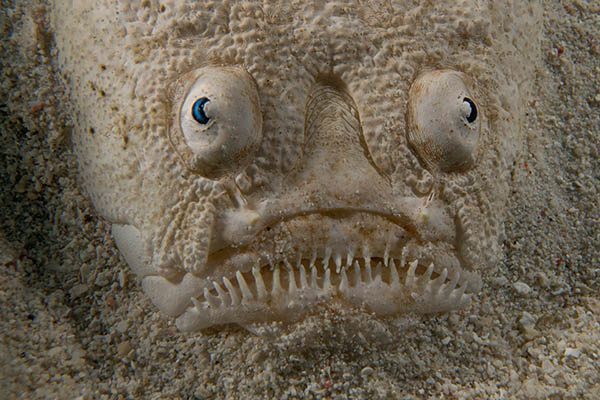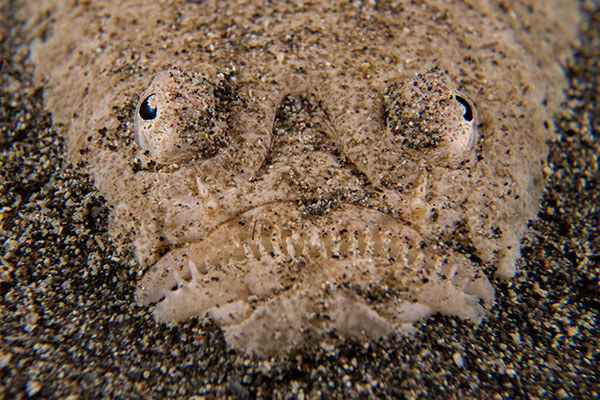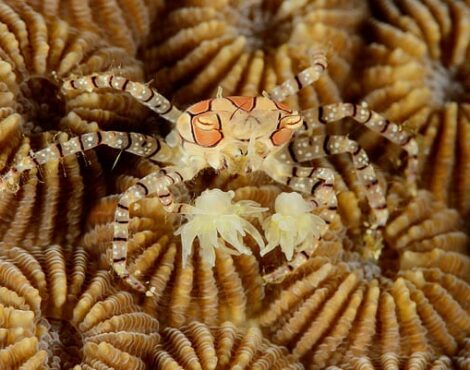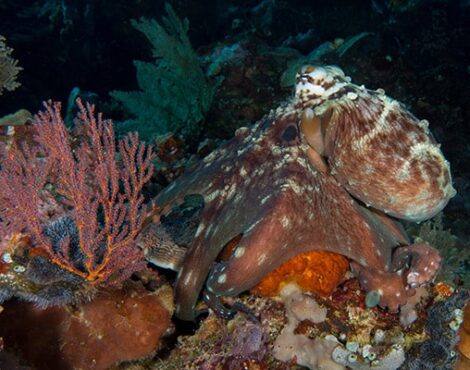
Descening upon the coral reefs and sandy slopes throughout Bunaken Marine Park at night will offer a very different experience to during the day. The countless colourful reef fish will have all but disappeared, and the ones that have remained look eerily different. Once the sun sets, the ocean becomes a very different, more dangerous place. The reef appears to move as thousands of different crabs and shrimp make their way out to feed. Cunning cephalopods take this opportunity to hunt â dazzling their prey with their colour changing chromatophores.
In the dark, open sand areas, lay the ambush predators. Those with fine tuned sensors or superb night vision that specialise in hunting with very little light â waiting for any soft bodied organism foolish enough to stay in the open to come into range. Odd looking creatures such bobbit worms, spearing mantis shrimp, and scorpionfishes are all mainly active when the sun is down, however, the fish that we are going to talk about takes odd looking to a whole new level.
With a face like a gargoyle that stares at you from below the sand, we can only be talking about the stargazer.
What is a Stargazer fish?
With over 50 different species, stargazers are a family of fish known as Uranoscopidae. They are found worldwide, and can be found living in both shallow and deep water.
They have large, flattened heads, with a wide, upturned mouth that faces upwards. Their common name âstargazerâ comes from their unusual and unique eye positioning, which sit directly on top of their head.
In Bunaken Marine Park, we can see the Uranoscopus suphureus, which goes by the common name âWhite margin stargzerâ, and grow to a maximum size of around 45 centimetres.
How does a Stargazer Hunt?
Stargazers are highly specialised ambush predators. They have the ability to rapidly bury themselves in the sand, only leaving their upturned eyes and mouth uncovered. This alone makes them excellent ambush predators, however they are also well camouflaged, and seamlessly blend in with the sandy substrate that they are buried in.
Similar to frogfish â another highly specialised ambush predator â stargazers have a lure that they can use to attract prey within striking distance. This lure is a small strip of skin that protrudes from their lower jaw, and they can rapidly retract and extend it to tempt any hungry fish passing by. Once any potential prey is within range, they rapidly bend their spine up to 60 degrees and lunge for their prey. Like most other ambush predators, this strike is extremely quick. The time it takes for a stargazer to initiate an attack and devour the prey whole takes less than 30 milliseconds.
As stargazers rely solely on vision for hunting, they must be able to keep their eyes above the sand in order to see. In order to do this, they have a special cavity behind their eyes which can be filled with liquid, causing proptosis, raising they eyes above the sand.
What does a Stargazer Eat?
Similar to other ambush predators, stargazers are not particularly picky about what they eat, although they tend to prefer soft bodied organisms, such as fish, octopus, and cuttlefish. However, unlike frogfish and bobbit worms, stargazers are not able to eat prey that is as large, or larger than itself, instead opting for smaller meals and eating more frequently.
Stargazer defence
The primary defence technique of a stargazer is to simply bury itself deeper into the sand and completely cover itself until the threat has passed. If that is not possible, they will flee, using their other, more deadly defence mechanisms.
Although not as powerful as stonefish and scorpionfish, stargazers are venomous. Their venom comes from two large spines, which are set just above their pectoral fins. Although their venom wont kill you, it can be extremely painful, and will cause localised swelling and can induce shock.
Perhaps more impressive, is there third method of defence, electricity. Although electrical discharge is not unique to stargazers, they are unique as they are the only electric fish that do not have sepcialised electroreceptors. This electrical defence comes from modified muscle tissues known as âsonic musclesâ, that are located just behind the eyes. This is used as a defence mechanism while they are swimming in the open, and any unsuspecting predators might be in for a shock of up to 50 volts if they try to attack.
Although their shock is not as powerful as other well known electric fish, such as electric eels â which are capable of producing up to 500 volts, more than enough to kill a horse. A shock from a stargazer will still be pretty painful. Many people believe the stargazer also discharges electricity to stun larger prey before eating, however any fish would have to be physically touching it to receive any shock.
Photographing Stargazers Fish

You will very rarely see the whole stargazer, and if you do find one swimming in the open, you will have to act very quickly as they will soon bury themselves again. Normally, you will only see the eyes and mouth sticking out of the sand, which is enough as these are the most impressive and identifiable features.
If you do find one, but only see the eyes, it is important not to disturb them. Many divers will try to remove the sand by gently wafting the water above them. This can work, however it is risky. In most cases, it will simply dig itself deeper and completely cover itself in the sand, however it may panic and try to flee, which puts the diver at risk of coming into contact with the venomous spine, or receiving an electric jolt.
If you do find one that is buried too deep, your best bet is to leave it alone, and come back to after a few minutes. Stargazers move themselves quite frequently, as the sand movement can attract other animals looking for a meal.
If you find a good subject, have a quick look around before you settle on the bottom and start taking pictures. Although stargazers are primarily solitary animals, they do sometimes gather together, and you donât want to risk keeling on one while trying to take a picture.
Where can I Dive with Stargazers?
As stargazers need soft sand or muck to bury themselves, you will need to head over to the North Sulawesi mainland to have a chance to spot one. Luckily, they are not particularly uncommon, and on one of our favourite night diving spots we have seen as many as five stargazers on a single dive.
They are also one of our most requested critters for night dives, so all of our guides know where to look. Still, due to their camouflage and their ability to completely submerge themselves, finding them requires patience, and sometimes they are buried too deep to spot.




